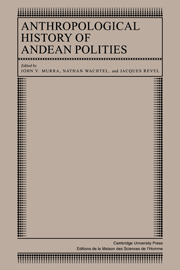Book contents
- Frontmatter
- Contents
- List of contributors
- Preface
- Introduction
- Part I Ecology and society
- Part II The ethnic group and the state
- Part III Systems of classification
- Part IV Symbolic representations and practices
- 11 Inka dynasty and irrigation: another look at Andean concepts of history
- 12 Urco and uma: Aymara concepts of space
- 13 Mirrors and maize: the concept of yanantin among the Macha of Bolivia
- 14 From asymmetry to triangle: symbolic transformations in northern Potosí
- Part V From ethnic polities to communities
- Bibliography of published source
- Index
12 - Urco and uma: Aymara concepts of space
Published online by Cambridge University Press: 05 October 2010
- Frontmatter
- Contents
- List of contributors
- Preface
- Introduction
- Part I Ecology and society
- Part II The ethnic group and the state
- Part III Systems of classification
- Part IV Symbolic representations and practices
- 11 Inka dynasty and irrigation: another look at Andean concepts of history
- 12 Urco and uma: Aymara concepts of space
- 13 Mirrors and maize: the concept of yanantin among the Macha of Bolivia
- 14 From asymmetry to triangle: symbolic transformations in northern Potosí
- Part V From ethnic polities to communities
- Bibliography of published source
- Index
Summary
They have to return to Omapacha, who created them. [Dioses y Hombres de Huarochiri.]
The fox from below: “This lower world is mine, and it begins in yours.” [José María Arguedas]
I, don Juan Santacruz Pachacuti Yamqui Salcamaygua, Christian by the Grace of God Our Lord, native of the towns of Santiago de Hananguayca and Huringuayca, in Canchi of Orcosuyu, between Canas and Canchis of Collasuyu, legitimate son of don Felipe Condorcanqui and doña Maria Guayotari. [Juan de Santa Cruz Pachacuti]
In 1613, eighty years after the Spanish invasion, the Andean chronicler Santa Cruz Pachacuti presented himself to his readers in terms that situate him in a universe still governed by indigenous categories of thought. First he invoked his village (with its two moieties, Hanan and Hurin), then the region where he was born (Canas and Canchis), and finally the vast territory of the Collao (or the southern quarter of the Inka empire).
Is there a meaning in the sequence? What was the pre-Conquest significance of this set of nested structures? The minimal level (the village) and the maximal (the Inka empire) are well known; but the concept of Urcosuyu, applied to the intermediate level (the region of Canchis), has not yet become an object of study.
The notion of suyu had a wide range of occurrence. It generally referred to a “subdivision” or “distribution,” without regard for scale: The individual's participation in a collective labor effort was a suyu, but so was a portion of land allocated or one of the four great divisions of the Inka state.
- Type
- Chapter
- Information
- Anthropological History of Andean Polities , pp. 201 - 227Publisher: Cambridge University PressPrint publication year: 1986
- 15
- Cited by



